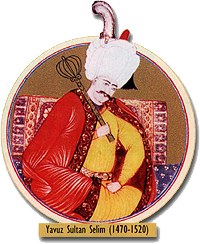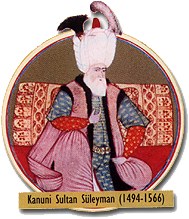THE OTTOMAN EMPIRE
The Classical Age, 1453-1600
1481-1512, Bayezit II. A man of intellectual tastes but the least significant of the first ten Ottoman sultans; comes to the throne with the support of the Janissaries; his position challenged by younger brother, Jem, who has himself proclaimed sultan at Bursa; in the ensuing civil war, Jem is defeated, flees to Egypt, then to Rhodes; Knights of St. John send him to France; Jem dies at Naples under suspicious circumstances in 1495. In 1489, Venetians get Cyprus by bequest from its Catholic ruler; leads to resumption of Ottoman-Venetian wars; Ottoman fleet commanded by Kemal Reis defeats Venetians; Ottoman cavalry aids within sight of Venice; Venetians sue for peace, lose more trade stations, but keep control of some lonian Islands. Otherwise, another period of respite making possible consolidation of recent conquests, internal reforms, regularization of the financial systems, and expansion of economic and commercial life

1512-1520. Selim I, Yavuz (The Grim). Forces his father to abdicate after a civil war among Bayezit’s sons; Selim defeats his brother, Ahmet, in Anatolia and has him executed in1513; resumption of expansionist policy; rise of Safavi dynasty in Persia; war against Ismail Safavi who had supported Ahmet; political rivalry accentuated by religious differences (Sunni Ottomans, Shi’i Safavis); Battle of Chaldiran, 1514, a victory for Selim; occupies Tabriz but obliged to withdraw when Janissaries object to further advance; Selim subdues Eastern Anatolia and Kurdistan in 1515, provoking the Mamluks; 1515, Selim embarks on second campaign against Persia, is diverted by Mamluk Sultan Kansu al- Gauri, ally of the Safavis; defeats Mamluks in battle near Aleppo in which Mamluk sultan is killed; Aleppo and Damascus surrender to Selim who offers peace to new sultan, Tuman Bey’, on condition he accept Ottoman suzerainty; offer is refused and Selim’s army moves against Egypt. Cairo falls on Jan. 22, 1517; Tuman Bey executed but Mamluks continue to be a powerful force in Ottoman Egypt. Last Abbasid ”Shadow Caliph” Mutavakkil is sent to Istanbul but returns to Cairo after Selim’s death. Sherif of Mecca acknowledges Ottoman suzerainty; Ottoman sultan assumes responsibility for the two Holy Cities and the pilgrimage routes. Expansion of Ottoman fleet; continuing rivalry in Mediterranean with Venice. Beginnings of unrest in Anatolia known as the Jelali Revolts.

1520-1556, Suleyman I, Kanuni (The Lawgiver, The Magnificent). Suleyman’s reign marks the zenith of Ottoman grandeur and power. Conquest of Hungary and Baghdad; expansion across North Africa to Morocco; naval supremacy in the Mediterranean and naval operations in the Red Sea and Indian Ocean; capitulations (commercial treaties) with European states; alliance with Francis I of France against the Hapsburg Holy Roman Emperor, Charles V; first Ottoman siege of Vienna in 1529; further development and regularization of law, administration, medrese education; the nakkashhane and patronage of the arts; the master architect, Sinan Pasha; Hurrem Sultan vs. Gulbahar Hatun, harbinger of the ”Sultanate of the Women”; population explosion (from about 12 million to about 22 million) leading to or exacerbating social and economic problems; revolts with imperial princes implicated; Sulayman dies while on a final campaign in Hungary.
1566 – 1574, Selim II, Sarhosh (The Sot). Incompetence of ruler permits political dominance of Grand Vezir Mehmet Sokollu; conquest of Cyprus from the Venetians, reestablishment of the Cypriot Orthodox Patriarchate, and the repopulation of the island; Battle of Lepanto (1571), nava1 defeat of Ottomans by fleets of the Holy League; the Ottoman Empire has reached the limit of its geographical expansion.
1574 – 1595, Murat III. Last of the Ottoman sultans to have had training and experience in military and administrative matters before taking the throne; growing power of the women of the Imperial Harem; death of Mehmet Sokollu (1579) marks end of period of relative stability at the center of the Ottoman system; wars with the Hapsburgs and with Persia; shifting trade routes, influx of New World silver, inflation, and other factors precipitate economic crisis at the end of the 16th c.; decentralization follows in17th and 18th centuries as Ottoman statesmen respond to new challenges, both domestic and foreign.
Assembled by Richard L. Chambers,
The University of Chicago
